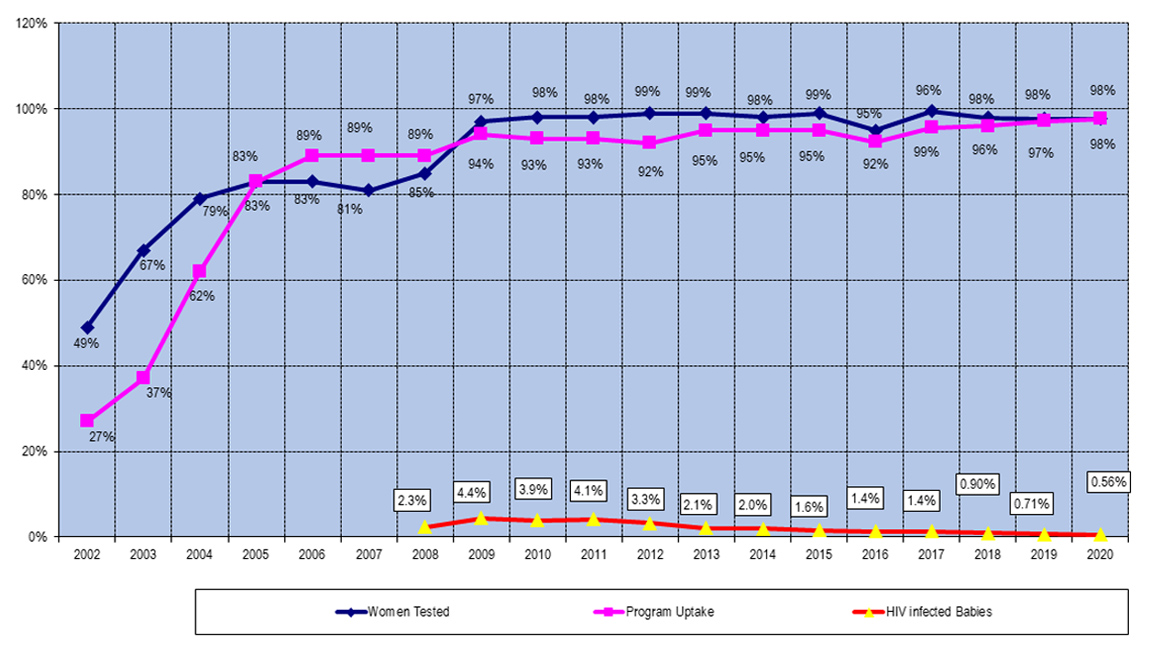CDC Partners with Botswana to Prevent Mother-to-Child HIV Transmission During COVID-19 Pandemic
Summary
- Botswana has one of the highest maternal HIV rates in sub-Saharan Africa. CDC and the Government of Botswana work to eliminate the transmission of HIV from mothers to their children.
- The estimated rate of mother to child HIV transmission has fallen from 40 percent in 1999 to 1.91 percent in 2020.
- CDC and the Government of Botswana continue their partnership despite challenges brought on by COVID-19.
With one of the highest maternal HIV rates in sub-Saharan Africa, the Government of Botswana is continuing its partnership with the U.S. Centers for Disease Control and Prevention (CDC) to eliminate the transmission of HIV from mothers to their children. For more than two decades, GOB has worked to implement the Prevention of Mother-to-Child Transmission (PMTCT) program which provides the best clinical services to pregnant and breastfeeding women and their children. Due to the PMTCT program, the estimated rate of mother to child HIV transmission has fallen from 40 percent in 1999 to 1.91 percent in 2020.
Botswana has one of the highest maternal HIV rates in Africa, over 26% in 2015. Effective collaboration between CDC and Government of Botswana has ensured that the PMTCT program continues without disruption despite the COVID-19 pandemic. The success of the program has placed Botswana among just a handful of African countries recommended by WHO to undertake a validation assessment for the Elimination of Mother-to-Child Transmission (EMTCT) and Botswana has submitted a validation report for possible certification. This effort places Botswana as the first African country to be validated on the path to elimination.

Challenges brought on by COVID-19
Although many programmatic gains were made in 2020, COVID-19 has affected the number of pregnant women who registered for care at Antenatal Care (ANC) clinics. The number of women who signed up for ANC decreased by 1.31 percent from 2019 to 2020. This decrease may be attributed to efforts implemented to reduce the spread of COVID-19 including restrictions to movement.
The documented numbers of pregnant women who initially tested negative for HIV before childbirth and later tested positive for HIV after child delivery increased from 0.2 percent in 2019 to 0.51 percent in 2020. While pregnant women continued to access PMTCT services, the Ministry of Health and Wellness (MOHW) experienced a reduction in program reporting rates by district health management teams which declined from an average of 99.8 percent in 2018 and 2019 to 96.2 percent in 2020. This is likely due in part to the redeployment of district PMTCT Focal Persons to COVID-19 response activities.
Finding solutions
Virtual meetings were enhanced to support district health management teams with submitting program tracking reports to MOHW during the appropriate reporting period. PMTCT master trainers were temporarily transferred as needed to support districts with trainings and mentorship.
To prevent new HIV infections, pre-exposure prophylaxis (PrEP) was offered to breast feeding and pregnant HIV-negative women.
To better determine the final diagnosis of babies exposed to HIV, a cohort monitoring registry is being rolled out and implemented.

PMTCT program results
As noted on the program trends chart above, HIV testing and treatment uptake were not affected by COVID-19. Both rates stand high at 98 percent in 2020. Early infant HIV diagnosis increased from 57 percent in 2017 to 83 percent in 2020.
The rate of HIV transmission in Botswana from mother-to-child were estimated at 0.56 percent based on PMTCT 2020 program data, and 1.91% based on Spectrum 2020 estimates. Spectrum estimates are modelled HIV estimates using the UNAIDS methodology. The model tries to correct for program data biases and produce population level estimates that include people living with HIV, HIV incidence, deaths caused by AIDS, and other measures.
